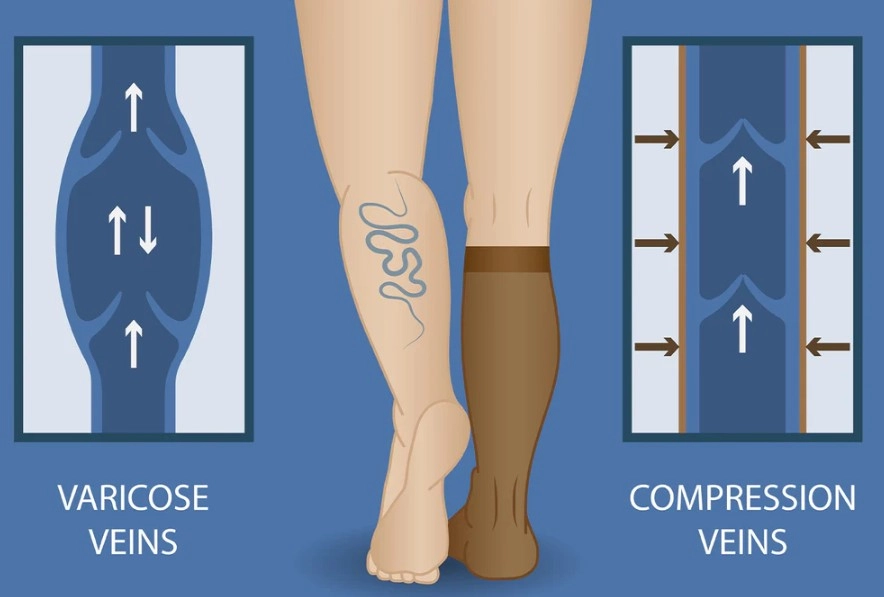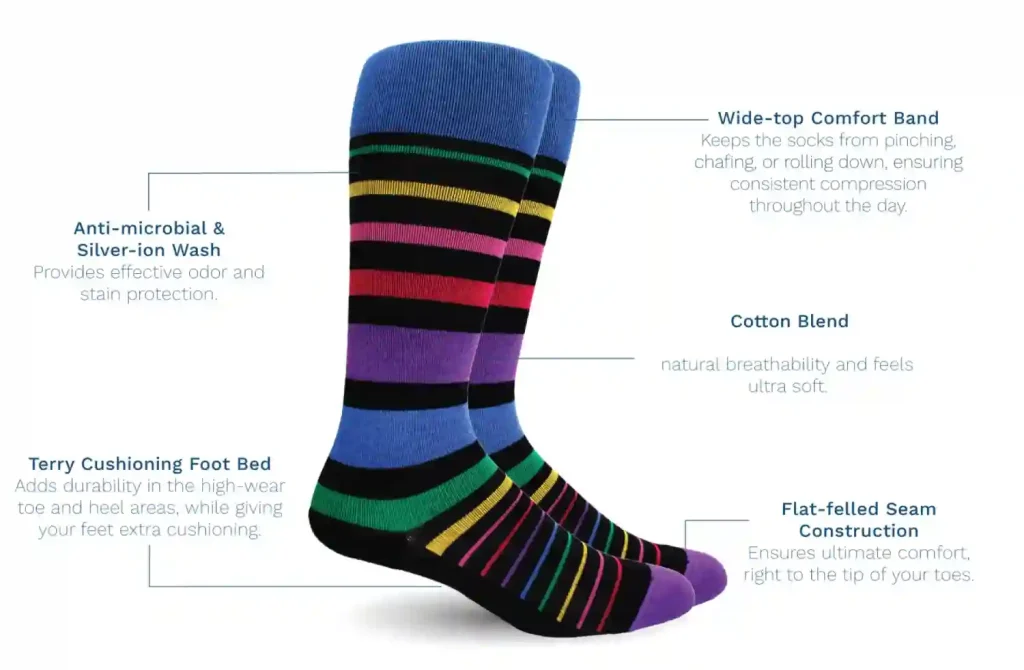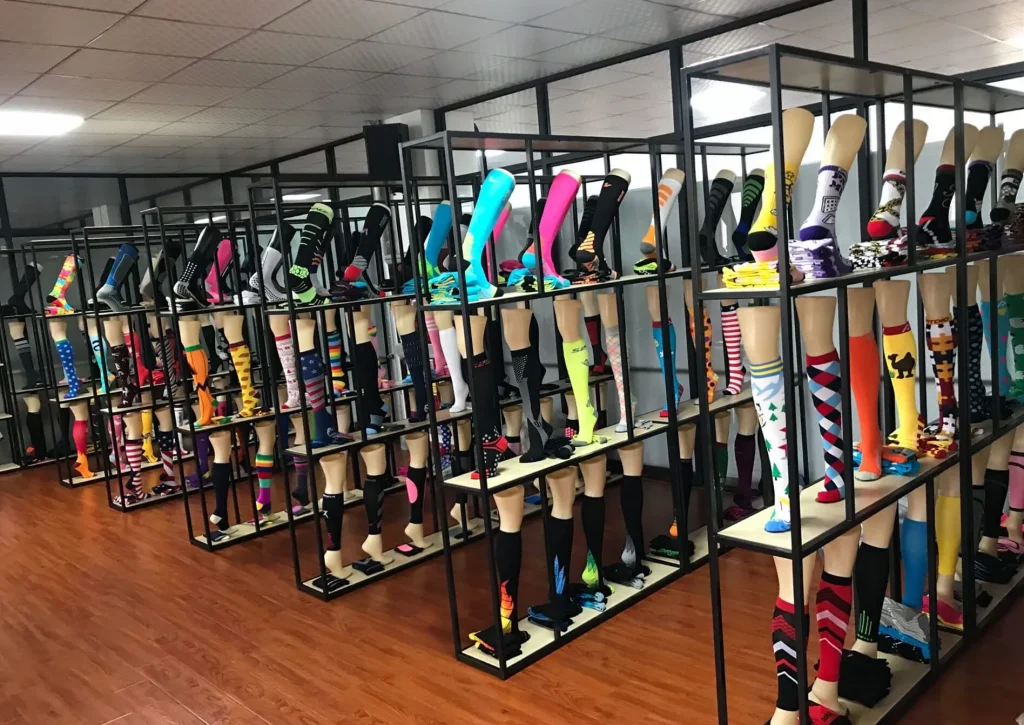Introduction
Nurses walk and stand more than most professionals. A typical shift lasts 10 to 12 hours—often without real rest. That workload brings serious leg issues: swelling, fatigue, and in many cases, long-term vein problems.
Retailers and healthcare brands have started to offer compression socks tailored for nurses—not just general socks, but designs meant to relieve the stress of long clinical hours.
Here’s a helpful review video from a registered nurse sharing her favorite compression socks for long hospital shifts and business travel flights:
In the sections that follow, this guide explains why more buyers are focusing on compression socks for nursing professionals, and how the right product makes a difference.
Why Nurses Are Turning to Compression Socks
Nursing is physically demanding. From start to finish, nurses are on their feet—walking, standing, responding fast.
This takes a toll on circulation. Gravity causes blood to pool in the lower legs. Over time, that means aching, swelling, and even varicose veins.
Compression socks apply gentle, graduated pressure. That pressure supports blood flow upward—reducing swelling, improving comfort, and keeping nurses mobile.

Unlike general-use compression socks, nursing-specific designs prioritize:
- Breathability during long shifts
- Moisture control in clinical settings
- Fit that stays in place under scrubs
For brands serving medical professionals, these socks are more than accessories—they’re functional tools to protect worker health.
Want to learn how compression works? See our detailed guide → 7 different types of compression socks
Common Leg Issues Faced by Nurses – and How Compression Socks Help
Leg discomfort is one of the most common physical complaints in the nursing profession. Why? Long hours of standing and walking, often without proper rest, cause constant stress on the lower legs. Here are the most frequent issues nurses report:

Swelling in the Ankles and Feet
After a 12-hour shift, it’s normal for nurses to feel tightness around their shoes or notice swollen ankles.
This is due to fluid pooling, caused by gravity and poor venous return. Compression socks apply upward pressure that helps prevent this buildup. Many nurses say their shoes fit better and legs feel lighter after using 15–20 mmHg compression.
Leg Fatigue and Muscle Soreness
Even healthy nurses often feel “heavy legs” near the end of a shift. The cause isn’t just overuse—it’s slow circulation and muscle vibration.
Graduated compression stabilizes muscles, reduces micro-movement, and improves oxygen delivery. That means less soreness and quicker recovery.
Varicose Veins and Spider Veins
Constant pressure in leg veins weakens vein walls over time. The result? Visible bulging veins, discomfort, or long-term health risks.
Compression socks help manage this. They support veins and slow disease progression—especially in early stages.
Night Cramps and Restlessness
Poor circulation can trigger calf cramps after a shift—or cause that “can’t rest” feeling at bedtime. A well-fitted pair of compression socks worn during work (and for a few hours after) often prevents these symptoms.
Occupational Injury Risk
Fatigue and foot pain lead to slower reaction time and poor balance. This raises the risk of slips or falls during night shifts or emergencies. Socks with light arch support and heel cushioning improve foot stability, offering more than just circulation benefits.
Compression socks aren’t a luxury for nurses—they’re a practical solution to daily pain and long-term vascular strain.
How to Choose the Right Compression Socks for Nurses
Nurses don’t need just any compression socks—they need pairs that match the pace and pressure of clinical work.
Compression level is key. For most nurses, 15–20 mmHg offers enough support to prevent swelling and leg fatigue, while staying comfortable for standing all day. Those with chronic vein discomfort may prefer 20–30 mmHg, especially during high-demand shifts.
Materials matter too. Nylon-spandex blends deliver consistent compression and durability, while microfiber enhances softness and sweat-wicking. Cotton-heavy socks tend to trap moisture and lose shape, which isn’t ideal for long hospital hours.
Fit also plays a big role. A proper pair should stay in place—no slipping or pinching. That’s why sourcing options with sizing based on both shoe size and calf circumference helps reduce returns and ensures all-day comfort.
Comfort details like seamless toes, cushioned soles, arch support, and low-profile construction make the real difference. For nurses wearing compression socks under scrubs, these small features help them stay focused—not distracted by aching feet.
What Nurses Value Most in Compression Socks: Design Features That Matter
When compression socks are worn 10+ hours a day, design details matter more than ever. For nurses, it’s not just about pressure—it’s about how the socks move with their body, hold up through a shift, and feel hour after hour.

Soft, non-binding cuffs are a must. A sock that digs into the calf leaves marks and discomfort. Nurses prefer socks that stay up without squeezing, especially during fast-paced movements.
Seamless toe design is another key feature. Seams cause friction—and in a 12-hour shift, that can mean blisters or soreness. Flat or seamless toe construction keeps pressure even across the foot.
Cushioned soles make long days bearable. Extra padding at the heel and forefoot helps absorb shock from hard hospital floors, reducing overall fatigue. It also provides more comfort inside clogs or slip-resistant shoes.
Moisture-wicking performance is essential. Nurses often work in warm environments and stay on the move. Breathable, sweat-resistant fabrics help keep feet dry, reducing odor and skin issues.
Arch support is a detail that buyers often overlook—but not nurses. A light compression band in the arch can reduce foot strain and improve stability during walking or quick pivots.
And finally, low-profile construction ensures the sock won’t bulk up under scrub pants. Many nurses wear fitted uniforms, so socks must sit close to the skin and look neat.
Each of these features may seem minor—but together, they define the difference between a sock that nurses tolerate, and one they reorder. For reference, you can also review this Top 10 Best Compression Socks for Nurses list by Shape to see how top-rated brands prioritize features like fit, moisture control, and comfort.
How to Encourage Reorders and Reduce Returns: Fit, Sizing, and Education
For brands and wholesalers selling compression socks to medical professionals, repeat orders and low return rates are key performance indicators. While quality is essential, what often separates successful suppliers from forgettable ones comes down to three practical things: fit, sizing clarity, and product education.
Fit Comes First
Even the best compression materials fail if the sock doesn’t fit well. Nurses are quick to notice socks that slide down, pinch at the calf, or cause heel slippage inside clogs. That’s why compression socks for nurses should be sized using both foot length and calf circumference.
Socks labeled “one size fits most” often get returned. In contrast, when customers feel the sock was “made for them,” they’re more likely to reorder—and tell others.
Clear, Visual Sizing Charts
Returns often happen when the buyer doesn’t know what size to choose. A sizing chart that’s too vague or only in US shoe sizes creates confusion, especially for international buyers or retailers ordering in bulk.
Provide clear charts that include:
- Shoe size ranges (US/EU/UK)
- Calf circumference (in cm and inches)
- Compression range (e.g., 15–20 mmHg)
Adding a visual size guide (with calf measurement example) helps reduce incorrect orders, especially in B2B transactions where buyers order for groups of staff.
Train Your Buyers: Easy Wear = Fewer Complaints
Many nurses trying compression socks for the first time think they’re too tight—simply because no one taught them how to put them on properly.
Include a small instruction insert or printable PDF for bulk buyers. Key tips:
- Turn the sock inside out to the heel
- Insert foot and slowly roll up
- Smooth wrinkles as you go
- Don’t bunch the sock or pull too hard
Also clarify how long the socks can be worn, how to wash them, and how long they typically last with daily use.
Small Efforts, Big Impact
If your brand can eliminate sizing confusion, simplify the wear process, and provide a consistent fit, you’ll dramatically improve buyer satisfaction. This builds brand trust, reduces customer service friction, and creates a smoother B2B partnership.
For retailers and e-commerce shops alike, these practical adjustments can drive conversion—and retention.
Ready to Supply Nurses with the Right Compression Socks?

Healthcare workers need reliable support every day. Offering high-quality compression socks for nurses means providing comfort, improved circulation, and lasting foot health. Max Hosiery specializes in custom compression socks designed for medical professionals. Contact us to request samples or discuss bulk orders tailored to your needs.
FAQ: Compression Socks for Nurses
What compression level is best for nurses who stand all day?
Most nurses prefer 15–20 mmHg for daily wear. For those with swelling or circulation issues, 20–30 mmHg may be better. Always provide both options when offering bulk orders.
How long can nurses wear compression socks during a shift?
Compression socks can be worn for the full duration of a 10–12 hour shift. If comfortable, they can also be worn post-shift to aid recovery.
What sizing method reduces returns for nursing compression socks?
Using a combination of shoe size and calf circumference offers the most accurate fit. Avoid one-size-fits-all solutions, especially for healthcare professionals.
Can compression socks reduce leg pain for nurses?
Yes. Properly fitted socks improve circulation, reduce swelling, and minimize fatigue, helping nurses avoid heavy legs or varicose vein issues.
What’s the ideal sock material for long hospital shifts?
Moisture-wicking synthetics like nylon-spandex blends or microfibers perform best. They hold compression, reduce sweat, and remain durable after repeated washing.
